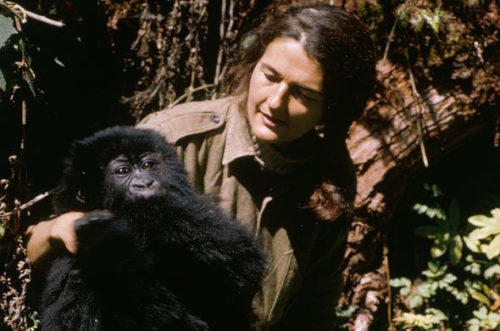Our Vanishing Cousins
by Revilo P. Oliver
SINCE THE PUBLICATION of the late Robert Ardrey’s African Genesis in 1971, the mountain gorilla has been a species of particular interest to us, if we take an intelligent interest in our own species and its problematical future. The gorillas, our cousins and a branch of the evolutionary line of which the several human species are at present the most conspicuous and numerous product, are a biological failure and their species is dwindling rapidly and inexorably to final extinction. Ardrey made the suggestion, which was startling at first sight, that the racial psyche of the gorillas was biologically aware of their hopeless plight and impending doom. That genetic despair was manifest in the etiolation of their vital instincts and progressive loss of the racial will-to-live. (ILLUSTRATION: Dian Fossey with infant gorilla)
When we Aryans ponder the plight of our own species, the only one for which we must feel a personal and necessary concern, we observe a phenomenal etiolation of our racial instincts and a progressive effacement of our racial will to live and to subdue other species for the benefit and enhancement of our own. There are, furthermore, obvious analogies. The gorillas, although they are physically by far the more powerful of the primates, have become peace-lovers in their degeneracy and they avoid combat, slinking away from adversaries they cannot frighten by idle blustering. They have lost the territorial imperative and no longer have homes or territories they defend from the intrusion of aliens. The mammalian imperative to perpetuate and multiply the species has become so feeble that males have become permissive toward their females and offspring, tolerating profligacy in the former and insubordination in the latter, and showing little concern for the welfare of either.
Gorillas unconsciously, and Aryans consciously, seem to acquiesce in the decline and eventual extinction of their species, and if we would apologize for them by explaining that they are retreating before enemies with whom they do not have the intelligence to cope or the courage to contend, is not that apology an admission that the species have become biologically obsolete and unfit to survive in the conditions in which they now find themselves? And may not our contemporaries’ endless gabble about “one world,” “brotherhood,” and similar frantic denials of reality emanate from a racial psyche which, far below the level of consciousness and implicit in the primordial force that makes an organism live, has somehow sensed that Aryans no longer have the vitality to strive and conquer and so must ineluctably go under in a world in which only the fit survive?
It is therefore with more than an academic interest that we take up a new study of a species that shows such disturbing analogies to our own, Gorillas in the Mist, by Dian Fossey (Boston, Houghton Mifflin, 1983; $21.50).(1) Miss Fossey, with a dedication of which only women are capable, devoted thirteen years of her life to close and intimate observation of mountain gorillas and to personal association with many of them, who accepted her companionship as though she were one of their group. She learned to recognize individuals by their features and distinctive nose-prints. (Portraits of a dozen of her best friends are assembled for comparison on the end-papers of the book.) She carried the young on her shoulders and became such a pal of adults that one photograph shows her playfully tickling a monster that could have literally torn her limb from limb. She gave fanciful names to the gorillas she knew best and followed their individual fortunes for years, often from birth to death. (Four pages of genealogical tables show the descendants of as many prominent males, usually with dates of birth and decease and a notation of the cause of death.)
(Footnote 1: The book is well printed with apt photographs. Miss Fossey writes a generally acceptable prose, but although the publishers are one of the most respected still in the business, their editorial staff was given to somnolence. One reads, for example, on p. xviii, “Dr. Leakey’s planning was indeed fortuitous [sic!]. In the six and a half years [since the last study of the gorillas] … the ratio of adult gorilla males to females … had dropped … accompanied by a halving of the population.” Miss Fossey did not intend nonsense, so she must have written, or intended to write, ‘fortunate.’ But even that will not do, although readers accustomed to the catachrestic and soloecistic prose of our contemporaries may guess the meaning that is not expressed. What the author meant is, ‘It was fortunate that Dr. Leakey decided to have a new study made so soon after the preceding one,’ i.e., before the population of gorillas dwindled to less than half.)
Miss Fossey, being a woman, even found spiritual values in the anthropoids with whom she associated for so many years. She became especially fond of a female gorilla whom she named Macho. (The name is a Swahili word that means ‘eyes,’ and has, of course, nothing to do with the Spanish adjective that means ‘male’ and is commonly misused by ‘hippies’ and journalists who try to be cute.) Of one encounter, she writes: “Suddenly I heard a noise in the foliage by my side and looked directly into the beautifully trusting face of Macho, who stood gazing at me. She had left her group to come to me. On perceiving the softness, tranquillity, and trust conveyed by Macho’s eyes, I was overwhelmed by the extraordinary depth of our rapport. The poignancy of her gift will never diminish.” Macho belonged to the harem of a gorilla whom Miss Fossey named Uncle Bert, and she was especially grieved when both were killed, evidently while trying to protect their infant son from either poachers or officials of the nigger government, who wanted to impress visiting journalists.
Poachers shoot gorillas to obtain their heads, for sale to tourists, and their ears, tongues, testicles, and small fingers, for use in manufacturing a potent tonic that is prepared and sold by native holy men, who practice sumu, the local variety of the ju-ju that is the common faith of the Blacks, who are, by nature, even more religious than “born again” Americans (2). Both religions, incidentally, venerate the cross as a sacred symbol.
(Footnote 2: Miss Fossey conclusively confirms the observations of Dr. Harry B. Wright (Witness to Witchcraft, New York, 1957), which I have so often cited in my remarks about religion. Nature has equipped Congoids for a Faith so intense that the mumbo-jumbo of their witch-doctors can excite a psychosomatic reaction that is lethal. Miss Fossey knew one Black male who died because a sorcerer condemned him to death by cutting the throat of a dedicated chicken, and she saw some of her own employees, who believed that a hex had been put on them, convinced they would die if the spell was not removed by a well-paid holy man; she saw them actually waste away before her very eyes until she provided the money for the magical cure, which soon restored them to health. It appears that the niggers’ belief in the supernatural can also be used to subject a victim to the will of the wizard. One of Miss Fossey’s employees surreptitiously took hair from her hairbrush and used it for an invultuation essentially similar to the invultuations practiced by Christians during the Middle Ages. The hair was affixed to a bit of wood carved to resemble her head (not, note, her entire body, as would have been necessary had her death beenintended); as soon as the scalp of the little image had been entirely covered with her hair, it was to be pulverized and the powder was to be introduced into her food and drink by her servant, a little at a time, so that the contamination would not be noticed. It was believed that this technique would render her totally subservient to the will of the magician, and such doubtless would have been the effect, had it been practiced on an African native. Miss Fossey, however, belonged to a race that nature has equipped with organs of rational thought and scepticism about supernatural hocus-pocus, although in many members of our race the organs atrophy for want of exercise.)
The gorillas have retreated to the slopes of several extinct volcanoes that lie in a narrow band across the boundaries of three territories in Africa that were once under civilized rule, but were restored to savagery by American taxpayers: the Belgian Congo (now called Zaïre), Belgian Ruanda (now called Rwanda for no good reason), and Uganda, which will retain its old name so long as British boobs finance its savages as “members of the Commonwealth.” The natives of the region are Congoids, chiefly of the Bantu tribe of Hutu (Bahutu), except that in Ruanda some Matusi (Tutsi) survived the massacres that the Americans incited and financed. The Matusi are an Hamitic people, who speak a language that is related to Ancient Egyptian and Coptic, and some anthropological theorists like to imagine that they are descended from the mongrelized Egyptians of the later Empire, who could have tried to colonize the interior of Africa. (The theory dates from Victorian times and doubtless suggested to Sir Henry Rider Haggard the background of his famous romance, She, and its sequels.) The Watusi have a considerable admixture of Black blood and most of them have features and complexions that are somewhat Negroid; they are noted for their physique and stature, since many of the men are seven feet tall, and they have supplied many of the basketball players who engross the mental capacities of some Americans. Although they had no real culture, the Watusi were more intelligent than the Bantu and naturally dominated the lower race in Ruanda until American do-gooders, with their morbid hatred of civilization, promoted “anti-colonialism” and supplied the numerically preponderant Hutu with modern rifles and ammunition to help them exterminate the “aristocratic” Watusi, who were not given modern arms and were overwhelmed by the vast mass of their inferiors. The resulting massacres were horrendous, but excited no qualms in the United States, where “intellectuals,” depraved by Jewish superstitions, are always pleased when a superior population, even if not Aryan, is destroyed by a lower species, thus producing progress toward a “democracy” of universal barbarity.
If your interest in gorillas is sociobiological and philosophical, you will be disappointed by Miss Fossey’s book. She seems never to have heard of Ardrey’s thesis or have thought of the biological implications of what she observed. The gorillas are indeed making rapid progress toward extinction. There were 500 of them in 1960 and only 242 in 1981. In one area, a population of 169 dwindled to 52 in seven years. Miss Fossey attributes the decline to the depredations of more human anthropoids, which became an important factor only in quite recent times and, as she may not have perceived, directly as a result of “anti-colonialism.” The savages were not only turned loose, but are heavily subsidized by Aryan idiots, who supply them with foodstuffs and medical services to accelerate their prodigious multiplication, and fawningly provide them with some trappings of civilization to encourage them to strut about as “emerging nations” in what would be a black-face farce, if the boobs still had wit enough to laugh at absurdity. Miss Fossey hopes that the gorillas can be preserved as an “endangered species” with funds supplied by civilized nations, but with the rapid breeding of Congoids, there will be constant encroachment on the tiny territory that has been theoretically reserved for the big apes and a continual diminution of their food. Gorillas are not carnivorous and subsist entirely on wild vegetation, spiced with insects. It takes an enormous amount of such food to nourish four hundred pounds of muscle, and an adult gorilla has to spend all his waking hours in eating.
If ability to survive environmental change is a test of intelligence, all apes are less intelligent than baboons, who are classified as monkeys, and Congoids, who are classified as human, two species that instinctively form tribal organizations under the rule of chiefs, whereas apes, like “liberated” Americans, reject the hierarchical principle and individuals think only of their own comfort and whims. Apes do that instinctively, while Americans have profited from the “back-to-the-ape” movement in their public schools.
Miss Fossey has compiled scientifically a vast amount of data about gorillas. They are less intelligent than chimpanzees. They do not think of using twigs or sticks to obtain desired food, and the cries by which they communicate among themselves are less numerous and significant (3). (It would be interesting to see a comparison between gorillas and their nearest congeners, the orang-utans of the East Indies.)
(Footnote 3: Miss Fossey does not mention the experiment conducted at an American zoo — in Atlanta, as I recall — a few years ago. A gorilla was provided with a television receiver, and it was found that his favorite programs were the ones that were most popular with American addicts of the boob-tube.)
Miss Fossey and her White assistants made a detailed study of the pathology of gorillas, and set forth the results with scientific precision in several appendices to her book. Endemic diseases are a chronic dysentery and hepatitis. (The latter will be recognized as the most popular disease of American homosexuals, since the epidemic of “AIDS” is still in its early stages. Apes are not practicing homosexuals, and I judge from Miss Fossey’s silence that male gorillas do not handle the sexual organs of other males as an assertion of social superiority, as do chimpanzees.) Gorillas often contract pneumonia, which is usually fatal. They are commonly infested with parasites, ranging from body lice to hookworms and tapeworms.
Although male gorillas seem indifferent to adultery by their females, it is noteworthy that when a male has taken a female with her child from another group, he kills the child before engendering offspring of his own. Gorillas, like all mammals except humans, copulate only when the female is in oestrus, but Miss Fossey observed some young males who tried to subigate sexually immature females, perhaps for practice (4). According to her observations, females become puberate at the age of ten or sometimes nine, but it is possible that some may be as precocious as the negress who was in an advanced stage of pregnancy when she was nine and attracted some attention because physicians announced they would abort her and the hospital was picketed by a crowd of nitwits, who believed that Jesus had injected a soul into the fetus, presumably intending to afflict Americans with another nuisance.
(Footnote 4: Persons who are much interested in such matters may wish to speculate about the significance of an odd incident reported on p. 81.)
The gorillas have an ardent champion in Miss Fossey and, no doubt, some of her colleagues, but it is unlikely that their biologically obsolete species can long be preserved from extinction. Whether our race will follow them into oblivion is still uncertain.
* * *
Source: Liberty Bell, December 1985






Cease all foreign aid, and create, where possible, living space for Mountain Gorillas.